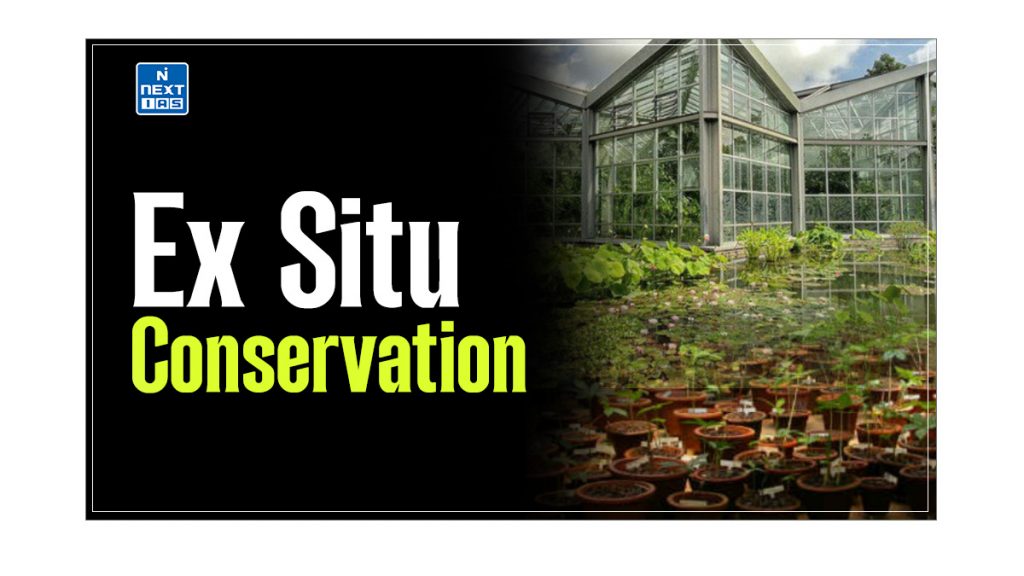
Ex Situ Conservation is a vital strategy for protecting species and ecosystems that are at risk. It complements in-situ efforts and provides a lifeline for endangered species. This article aims to study in detail ex situ conservation, its meaning, and various methods, including Botanical Gardens, Zoological Parks, Gene Banks, Seed Banks, Cryopreservation, etc.
What is Ex Situ Conservation?
- Ex Situ Conservation is the preservation of components of biological diversity outside their natural habitats.
- This involves the conservation of genetic resources, as well as wild and cultivated species, and draws on a diverse body of techniques and facilities.
- The reintroduction of an animal or plant is a prominent example of this type of conservation method.
- For instance, Gangetic gharial has been reintroduced in the rivers of Madhya Pradesh, Uttar Pradesh and Rajasthan, where they were extinct earlier.
Methods of Ex Situ Conservation of Biodiversity
Prominent techniques and methods of ex situ type of conservation of biodiversity include:
- Botanical Gardens
- Zoological Parks
- Gene Banks
- Seed Banks, and
- Cryopreservation
Each of these methods has been discussed in detail in the sections that follow.
Botanical Gardens
- Botanic gardens are institutions that hold documented collections of living plants for scientific research, conservation, display, and education.
- Conservation is being realised by means of seeds, cuttings, and tissue or cell cultures, and genetically representative permanent collections should be secured for conservation, (re-) introduction, research, and education.
Zoological Parks
- It is a facility in which animals are housed within enclosures, displayed to the public, and in which they may also breed.
- The breeding of endangered species is coordinated by cooperative breeding programmes containing international studbooks and coordinators, who evaluate the roles of individual animals and institutions from a global or regional perspective, and there are regional programmes all over the world for the conservation of endangered species.
Gene Banks
- Gene Banks preserves genetic material, such as DNA, sperm, and embryos, from endangered species.
- These resources can be used for research, breeding programs, and potential future reintroductions.
Seed Banks
- Seed Banks store seeds under specific conditions to preserve genetic diversity.
- Hence, they are a type of gene bank.
- They have considerable advantages over other methods of ex situ conservation, such as ease of storage, the economy of space, relatively low labour demands and consequently, the capacity to maintain large samples at an economically viable cost.
- There are many reasons to store seeds, such as:
- To have the genes that plant breeders need to increase yield, disease resistance, drought tolerance, nutritional quality, taste, etc., of plants used in agriculture (i.e., crops or domesticated species).
- To forestall the loss of genetic diversity in rare or imperilled plant species in an effort to conserve biodiversity ex situ.
Cryopreservation
- Cryopreservation is a process where organelles, cells, tissues, extracellular matrix, organs or any other biological constructs susceptible to damage caused by unregulated chemical kinetics are preserved by cooling to very low temperatures (typically -80 °C using solid carbon dioxide or -196 °C using liquid nitrogen).
- At low enough temperatures, any enzymatic or chemical activity that might cause damage to the biological material in question is effectively stopped.
- It is a useful method for long-term storage of germplasm, especially for plant species that are difficult to conserve as seeds due to low desiccation tolerance.
- For aquatic species, it has limited application because female gametes and fertilised eggs usually cannot be frozen.
- For livestock, it usually means the preservation of germplasm for the purpose of genetic conservation.
- This distinction is more relevant for livestock than for other sectors because it is more widely applied for uses other than conservation.
Uses of Cryopreservation
Cryopreservation can be used for the following purposes:
- Conservation of plant germplasm
- Vegetative propagated species (root and tubers, ornamental, fruit trees)
- Recalcitrant seed species (Howea, coconut, coffee)
- Conservation of tissue with specific characteristics
- Medicinal and alcohol-producing cell lines
- Genetically transformed tissues
- Transformation/ Mutagenesis competent tissues (ECSs)
- Eradication of viruses (Banana, Plum)
- Conservation of plant pathogens (fungi, nematodes)
Conclusion
Ex Situ Conservation is an essential component of global biodiversity preservation efforts. A balanced approach that integrates ex situ and in-situ conservation strategies is crucial for ensuring the long-term survival of species and the health of ecosystems. Understanding the role of ex situ method of conservation in the broader context of biodiversity management is important for effective policy-making and implementation.
Frequently Asked Questions (FAQs)
What is another name for ex situ conservation?
Another name for ex situ type conservation is off-site conservation. This term highlights the practice of conserving species outside their natural habitats, such as in zoos, botanical gardens, etc.
Why do we need ex-situ conservation?
This type of conservation is necessary for several reasons, including – Species Recovery, Research & Education, Protection of Species from Threats, etc.






